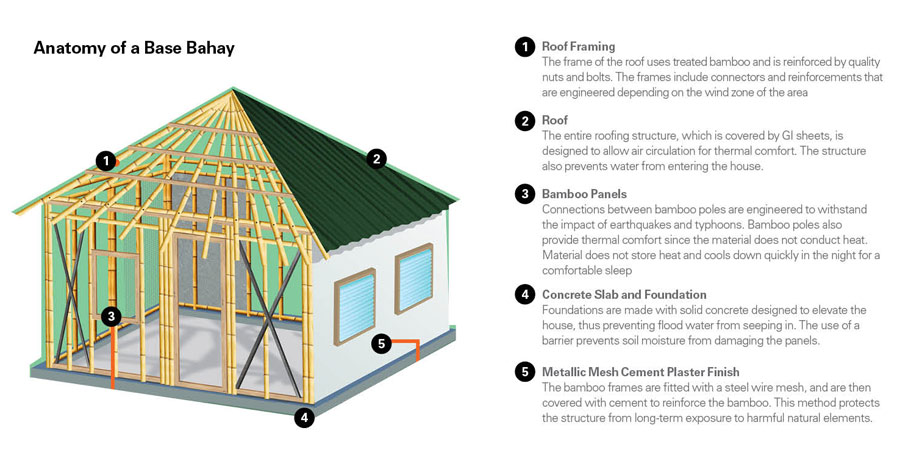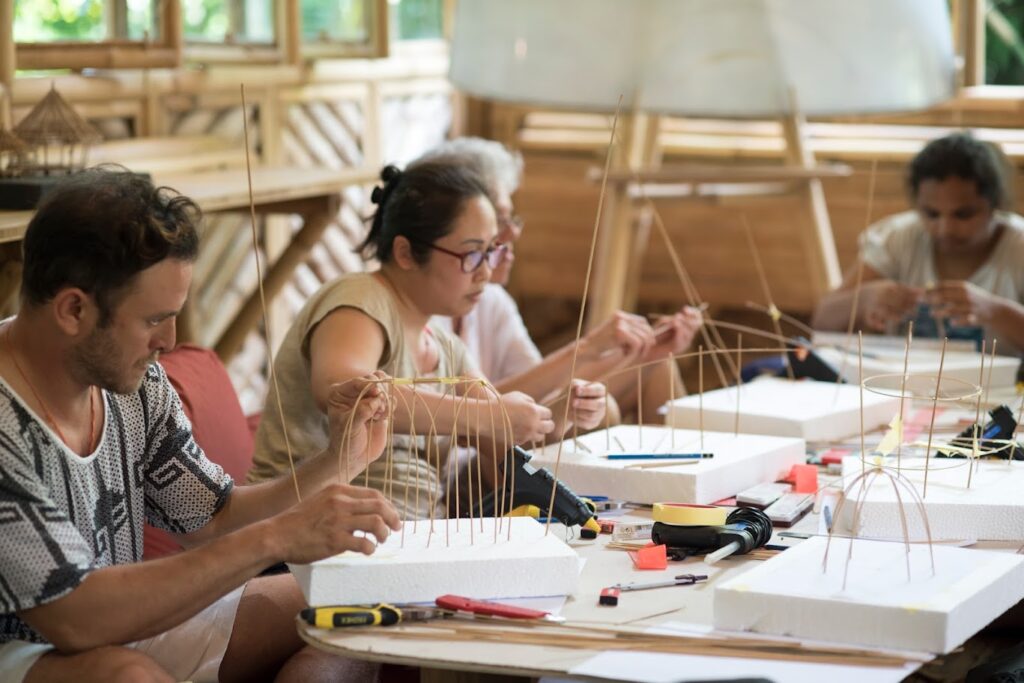Is Bamboo a Reliable and Resilient Construction Material for Natural Disasters Like Earthquakes?
By Layane Al Madani | August 19, 2022 | Construction -

Bamboo structures can survive earthquakes if they are designed, constructed, and maintained well. They are affordable and safe options that have been used in earthquake-prone areas for centuries, and new technology is proving them still relevant today.
As we've seen over the past 15 years of bamboo construction in Bali with the work of IBUKU, it is clear that bamboo can be used beyond post-disaster temporary shelters. It can be used to build permanent structures that are resilient to natural disasters. Historic examples, modern technologies and people like Luis Felipe Lopez, a collaborator of Bamboo U, are proving time and time again that bamboo can be a more earthquake-safe material than other equally priced, or even more expensive, materials.
An Under-Rated Earthquake-Resistant Construction Material
You may have heard about the use of bamboo in the temporary shelters created in humanitarian aid efforts after an earthquake, but bamboo can actually be very valuable in the construction of buildings that can withstand earthquakes. Why should we look towards bamboo as a temporary solution after a disaster when we could save lives by building with it in the first place? Bamboo’s is a great option for building homes and shelters in earthquake-prone regions, given that the structures are well designed, constructed, and maintained. From old traditional structures to modern builds, several examples from across the globe have proven themselves against the very forces of nature that have brought down concrete and brick buildings.
In this article we will look into:
- Bamboo Structures’ Anti-Seismic Properties
- The Impact of Design on Building Safe Structures
- Global Examples of Successful Structures

Bamboo Structures’ Anti-Seismic Properties
- Bamboo’s good strength-to-weight ratio means that the structure is subjected to lower forces during earthquakes and, in the case of collapse, the light bamboo poses less of a risk to the occupants
- Bamboo is flexible due to its tensile strength, its fibrous morphology and its lightweight nature, make it resistant to lateral shocks from earthquakes
- Bamboo’s bi-composition of lignin and vascular bundles acts to dampen vibrations. Each of bamboo’s primary constituents has a different density and therefore a different frequency at which they want to vibrate. When vibrations go through the bamboo, these two frequencies cancel out one another which generates stability in the culm.
- Bamboo’s joinery systems, such as nails, traditional carpentry connections and rope, can be made to absorb the shocks of earthquakes and distribute the forces so that the different parts of the structure move together
- Bamboo can be accompanied with other materials, such as mud, vegetable materials and other daubs, which can increase the structure’s ability to absorb energy

Impact of Design on Building Safe Structures
Like everything in the construction world, designing bamboo housing is context dependent. In some earthquake prone regions where bamboo is native and forms part of the vernacular architecture and the local labour skill, it can be an affordable, durable and highly renewable material to push forward. There are also some design criteria that when followed, along with proper selection and treatment of the bamboo, can increase the safety of the structures.
As seen in examples around the world, bracing the walls of the structure using different systems such as shear walls and moment frames can help to resist earthquake loads. Regardless of the constructive system chosen, good design for earthquakes requires keeping the structure, and particularly the roof, lightweight in order to reduce the force it will undertake. Even the form of the structure can impact its reaction to earthquakes. For example, overly long floor spans can decrease the structure’s efficiency while circular structures can be optimal, as observed in many vernacular housing models. Good design also goes down to the details – using tried and tested joinery can successfully distribute loads and shocks, as well as connecting and securing each component of the structure well. The ideal design of earthquake-resistant bamboo structures considers all of these criteria, uses healthy bamboo, and considers the context in which it is made.

Successful Global Examples
A popular example of bamboo housing that has been used in earthquake-prone regions across South America is bahareque. Some examples of bahareque construction include cladding with bamboo splits, canes or twigs and daubing using mud or cement, with roofs made of clay tiles.

A Bamboo U Online Course facilitator, Luis Felipe Lopez, created the Colombian bahareque building code with the Colombian Association of Seismic Engineering (AIS), a code which was adopted in many other countries to push forward the use of these earthquake-safe bamboo houses. Recently, Luis Felipe and his team and collaborators have adapted this traditional bahareque system to build hundreds of safe homes in the Philippines, a country extremely prone to an array of natural disasters.
This video shows an overview of some of the work, from lab to field, that the Hilti Foundation does:

Anatomy of a Base Bahay house (Base Bahay)Another modern technology called IPIRTI-TRADA, developed in India is comprised of a grid of split bamboo which is tied together with steel wire and fixed onto steel dowels that pass through bamboo columns. Wire mesh is fixed onto the outside of the grid and covered in mortar. This system makes it so that the whole structure acts as a single strong unit since each component is so well connected.
This video shows a shake-table test of a house using similar technology and bamboo frames:
The Future of Earthquake-Safe Bamboo Houses
Bamboo can be a safe construction material in earthquake-prone areas. To encourage its use it is important to spread knowledge about how to select and treat bamboo to communities. This information is so important, that we’ve dedicated a big part of our Bamboo U online courses to making this seemingly overly-technical topic accessible to everyone. It is also exciting to see bamboo increasingly included in building codes around the world. During a live talk in our latest Online Course, Luis Felipe explained the importance of these codes, many of which he has led and contributed to. To learn more about these topics and gain insights from key players in the bamboo world, check out our next Bamboo U Online Course. Or to see some of these processes in person, join us in our upcoming 11-day in-person courses!
Sources:
Dezeen, Ramboll uses bamboo to build earthquake-resistant housing in Indonesia, https://www.dezeen.com/2019/12/31/bamboo-template-houses-ramboll-earthquake-indonesia/
Better Bamboo Buildings, Sebastian Kaminski - Bamboo Buildings in Earthquakes, https://www.betterbamboobuildings.com/home/3rn12lawxv5ouxu9gzzyy3ftdhv051
Building with Bamboo, Gernot Minke (book)
INBAR, Bamboo - a Strategic Resource for Earthquake-Prone Regions, https://www.inbar.int/bamboo-a-strategic-resource-for-earthquake-prone-regions/
IPIRTI, Seismic performance of Bamboo housing– an overview, https://worldbamboo.net/wbcx/Sessions/Theme%20Architecture%20Engineering%20Social%20Housing/Vengala,%20Jagadish%20et.%20al.pdf
Jagadish Vengala and Raghunath Seshagiri Rao, Sustainable bamboo housing for the earthquake-prone areas, https://www.researchgate.net/publication/347081049_Sustainable_bamboo_housing_for_the_earthquake_prone_areas

Layane is an architect with a specialization in urban resilience. She is passionate about vernacular architecture, social equity, and decolonized practices.
OCTOBER 10-21, 2025
The 11 Day Bamboo Build & Design Course in Bali
In 11 days, we'll show you how to build bamboo structures we’ll share all that it takes to build with nature.
Start Anytime
The Bamboo Harvesting Course
The Bamboo Harvesting Course is an online step-by-step training to harvest and care for your bamboo clumps to ensure their longevity and productivity. This maximizes the potential of this beautiful grass as a rapidly renewable resource.Whether you are an architect, builder, or sustainability enthusiast, this mini course will enable you to utilize this rapidly regenerative resource as a durable construction material.It will help remove any fear or doubt about the durability of bamboo and help you build reputable bamboo structures that stand the test of time!
















